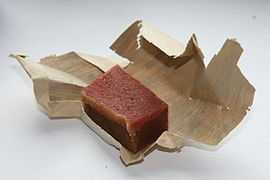Guava jelly

Guava jelly (Spanish: bocadillo (de guayaba), eng. "(guava) snack") is a Colombian confectionery made with guava pulp and panela, which is consumed abundantly throughout Colombia, one of the largest guava producers in the world. The town of Vélez in the Santander Department is a major centre of production for the sweet, hence the alternative name "bocadillo Veleño".[1]
In Venezuela the form of consumption is similar to that of Colombia, where the product is also called "bocadillo".
Bocadillo is commonly accompanied by cheese, spread upon bread, or simply eaten on its own. It most often takes the form of a small rectangular block, with a firm consistency and a deep red colour, giving it a similar appearance to the related Spanish dessert dulce de membrillo. Another dessert closely related to bocadillo is the Brazilian goiabada, also made from guava.
In 2006, the bocadillo veleño was nominated for the cultural symbol for Colombia in the contest organized by the magazine Semana.[2]
Preparation
Bocadillo is prepared much like other conserves, jams, and jellies. The guavas are first washed and peeled, before being mashed into a pulp, which is strained to remove seeds. This pulp is then boiled in water along with panela, or refined sugar, at a low temperature for several hours until the mixture has a thick consistency. This liquid is left to cool off, whilst being moulded into blocks, acquiring its characteristic firm texture once fully cooled.[1][3]
Bocadillo de guayaba is traditionally individually wrapped in the leaves of the bijao (calathea lutea), both to preserve the food, and to enhance its flavour.
See also
References
- ↑ 1.0 1.1 Restrepo, Cecilia (October 2007). "El Bocadillo Veleño" (in Spanish).
- ↑ Revista Semana. "El bocadillo veleño". Retrieved 2011-03-24.
- ↑ http://www.juanjosemora.com.ve/wiki/index.php?title=Bocadillos_de_guayaba